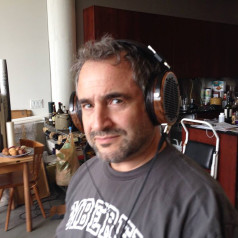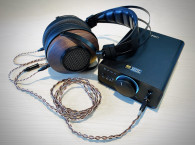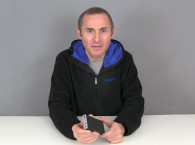Headquartered near Chicago, IL, CEntrance is known for its co-development and technologies licensed to many pro-audio and high-end consumer companies. In 2009, CEntrance introduced a portable product called DACport, a small, USB-powered digital-to-analog converter plus headphone amplifier. In 2015, it added DSD playback and sampling rates up to 384 kHz on the ultra-slim DACport HD. Recently, CEntrance added a rechargeable battery to its new DACportable, featuring the AK4490 D/A chip coupled with a Class-A headphone amplifier with digital volume control, which audioXpress received for review.

These days, my commute consists of a 45-minute drive to the western suburbs of Minneapolis, all the while listening to TIDAL or podcasts via Bluetooth from my phone. For many folks, their phone is their main source of entertainment, with streaming and local files providing the content. However, most phones are anything but high fidelity, and some manufacturers have seized the opportunity to address that shortcoming. One approach is an “audiophile” phone, which is not that crazy since many DAP portables are basically smartphones without the cellular radio.
A few manufacturers have taken a more purist approach. CEntrance, long known for its high quality, reasonably priced electronics, have created the DACportable, a digital-to-analog converter that also gives you a wideband, low total harmonic distortion (THD) Class-A headphone amplifier. Thanks to its built–in power, it won’t contribute to draining your phone or tablet either. Moreover, the battery power provides ultra-low noise, removing contamination from its asynchronous USB power rail.
The Technology
The Class-A circuitry is DC coupled, and is powered by a bipolar, ±9 VDC supply. This ensures excellent headroom for a consumer product. The direct coupling exposes any DC offset in the source file, though offset is rare these days for two reasons. Modern ADCs have eliminated the problem at the source, and DAWs (when properly configured) reveal any offset during post–production where it can be removed. The advantage of DC coupling is solid low-end amplitude and phase response all the way down to 0 Hz.
As with all proper DAC designs, CEntrance guarantees a bit-perfect audio stream. Michael Goodman, the man responsible for all things CEntrance, told me the company is particularly proud of its USB implementation, which it has “licensed widely in both the pro and CE audio industries.” By widely, he means more than 48 audio firms, from consumer electronics stalwarts PS Audio, Bel Canto, Playback Designs, and Accuphase, to a range of pro and MI giants including Ernie Ball, Tascam, Crane Song and Mackie. Since CEntrance is an official third-party design house for XMOS, DACportable employs one of its microcontrollers.
Goodman mentioned that, “As a consulting company, we’ve enabled dozens of audio brands with USB technology. It was natural for us to choose XMOS for this design. We make our own Windows drivers and write our own code for XMOS chips.” If you were to compare the audio bit stream entering the DACportable’s USB receiver, from the audio playback application to the bit stream right at the DAC inside the device, you would see the exact same data, with nothing altered or lost.
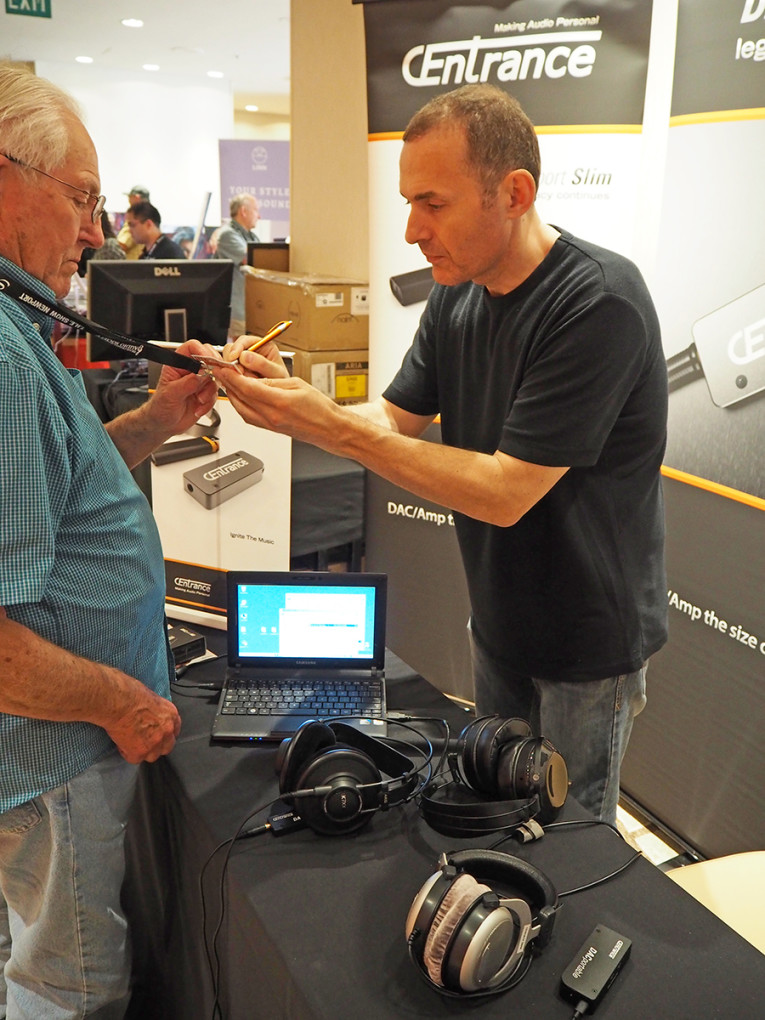
The product is assembled in the US, is RoHS compliant, and supports all the modern rates, at 24 fixed or 32 floats: 44.1 to 384 kHz, along with baseband DSD and DSD2 (5.6448 or 6.144 Mbps). On one side of the unit is a 20 dB gain switch to better match sensitivity between low impedance in-ear monitors (IEMs) and 600 Ω studio cans. The product consists of a 98 mm x 41 mm x 21 mm black metal rectangle, with one rounded corner that contains a small, continuous volume wheel.
When asked if the variable gain logarithmic control is analog or digital, Goodman recounted his journey with gain control implementations. “Our older products, such as the venerable DACport Classic, used analog gain potentiometers for volume adjustment. While that’s the most straightforward method, the pot eventually becomes dirty and starts to develop an unwanted, scratchy sound. This would happen after several years of use, but we still felt that it wasn’t a good customer experience. So, when developing DACportable, we made a decision to switch over to a digitally controlled potentiometer. The thumb wheel pot in the DACportable doesn’t pass audio. Instead, it creates a control signal for the 32 bit microprocessor, which in turn sends commands to adjust the volume in the digital domain. We use…256 steps and zero crossing gain adjustment to make sure that the volume control is smooth and linear. It actually feels better than a regular pot. And the benefits of digital control are clear—your right and left (channel gain) always remains perfectly balanced, even down to the lowest volume settings, which is not possible with analog pots, and control is not subject to (wiper) noise, which are inherent with mechanical pots.”
Along with the 20 dB gain switch are two EQ switches. All three are recessed to avoid accidental changes during transport or use. The EQ, a two-position flat vs. 3 dB of boost, is voiced, according to Goodman “…to be both musical and subtle. This is not a typical boom box ‘smile curve.‘ The LF EQ option features a specially developed, custom boost curve to add punch without mud. The HF EQ is designed “…to add just the right amount of ‘sheen’ at the top range of the audio spectrum, to accentuate the airy qualities of strings and wind instruments.”
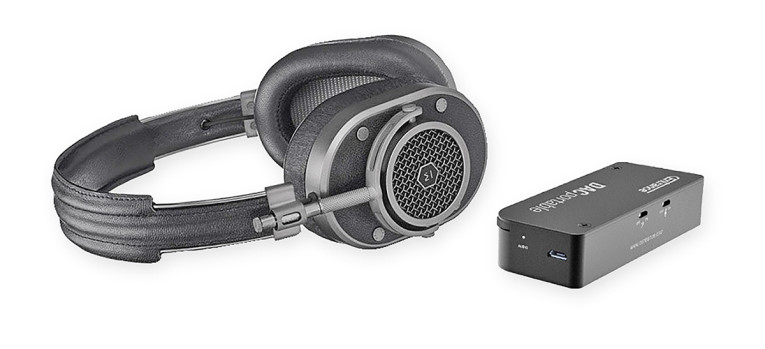
DACportable shares a lot of technology with its less expensive new little brother, the DACport HD. Both products feature the same sample rate support and high output drive capabilities. Actually, the DACport HD was the first to offer the new “Amp Extreme,” a headphone amplifier design with the highest output power, 775 mW into 32 Ω, and the lowest output impedance yet (1 Ω). Compared to the DACport HD, DACportable adds an eight-hour, rechargeable battery and the aforementioned two-band EQ from CEntrance’s award-winning HiFi-M8. As we all know, power is the Achilles heel of mobile computing. Hence, the built-in battery, along with welcome compatibility with iPhone and Android.
The rechargeable battery uses lithium-polymer technology, the newest formulation with the highest energy density available for CEntrance products. The battery is sized at 3,000 mAh and, according to Goodman, it will confidently give you eight hours of play time. Using my Audeze EL-8 and LCD-3 cans and playing at what I consider reasonable levels, I routinely got 10 hours.
“We give our customers versatility in terms of charging. The unit can be charged from a USB port or a small 0.5 A iPhone charger cube, but also from the larger, iPad-style 2.5 A charger. With the latter, the charging time can be as quick as four hours and you are ready to roll again,” said Goodman.
The Design
The design brief for the DACportable, along with new challenges the designs team came up against, can be summarized as miniaturization. A surfacemount assembly, with a double-sided PCB, made the overall package smaller. The PCB itself features four layers of copper for extra grounding and shielding, and is passivated with gold plating to reduce corrosion and accommodate fine pitch components, such as the microprocessor that comes in a ball grid array BGA package for higher density, better heat conduction, and lower interconnect inductance. Goodman told me it was a process of refinement.
“We already had a lot of experience with battery charging technology, D/A conversion, amplification, and USB interfacing so those parts just needed to be made much smaller in order to fit a device that can easily (fit comfortably) inside your pocket or a laptop bag. Making everything fit on the tight PCB required multiple rounds of prototyping, tweaking and adjustments for best usability and absolute pristine sound. That took months of work and now we are shipping what is revision 5.1 of the PCB,” explains Goodman.
As with all current microcontroller-based products, there’s a lot of software under the hood for the best user experience. The latest firmware adds a timed power down feature, which turns the device off after several minutes of inactivity. This is convenient if you’ve forgotten to turn it off. CEntrance implemented the feature after experiencing a dead prototype when it was most needed. The unit waits patiently and, if nothing is playing, it will turn itself off to preserve charge. There is nothing more frustrating than a product that expires overnight because you forgot to power it down.
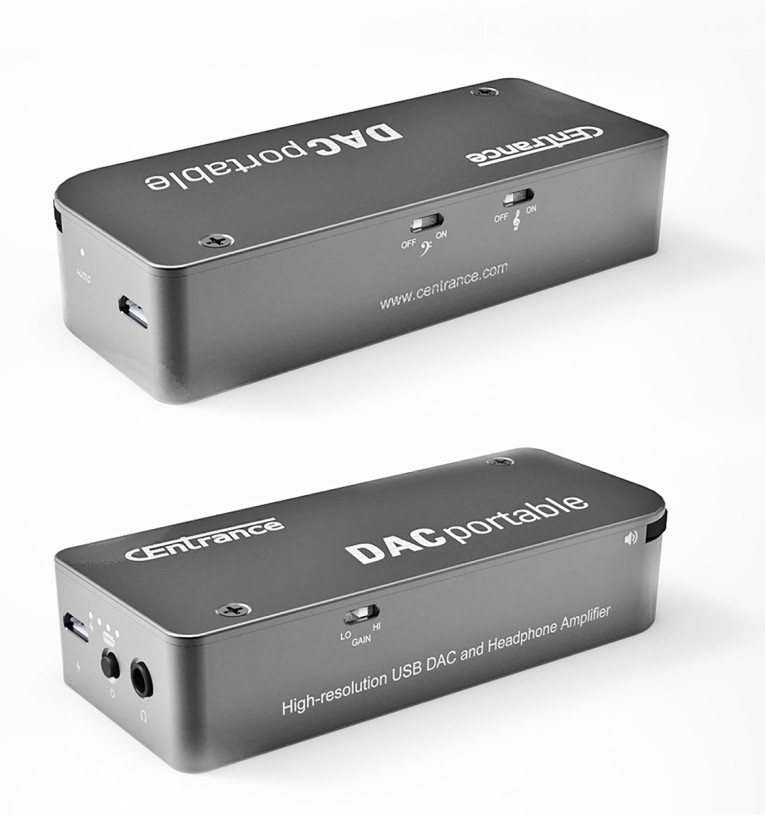
High performance requires very clean power, and batteries can provide that when properly managed. When I asked how many regulators are hiding inside the DACportable, I was surprised to learn there are five: one for the rapid battery charger, another for the 3.3 VDC digital supply, two more for the bipolar analog supply mentioned earlier, and a separate ultra-clean 5 VDC supply for the DAC itself.
Goodman stressed that, “All supplies are custom, of course.” Those five don’t include a special battery gauge chip that measures battery voltage with “single percent precision.” This IC silently optimizes battery life as the battery ages over years of use, again to provide the best user experience. All of the power supplies are sequenced by the microprocessor, so only the subsections needed are powered up and in the sequence that optimizes performance.
In addition to the classy Class-A analog path and careful power massaging, another contributor to the outstanding sound is the clocking. Two custom, milspec clocks provide much tighter temporal tolerances, along with a wider immunity to temperature variation. The DACportable exhibits 1 ps of jitter, an order of magnitude below the threshold of golden-eared audibility.
Listening First, I had to match the gain between the DACportable and the other two micro DACs I had on hand: the admirable and functionally similar Sony PHA-3 and the slightly elderly Geek Out 1000 (GO1K) from LH Labs. Both the PHA-3 and the DACportable have external manual gain controls, while the Geek Out lacks a gain control, taking its gain setting from the host. So, I set hardware gain controls at maximum, and played a brown noise track out of TIDAL to build a table of gain compensations for each device. The GO1K had the least gain, the PHA-3 had the most, while the DACportable was in between. All of them could easily drive any of my cans, from my closed back work headphones, the 32 Ω AIAIAI TMA-2-S01, to my high sensitivity, 25 Ω Westone W60 reference universal IEMs. For this evaluation, I settled on my open-back circumaurals, the 110 Ω Audeze LCD-3.

Because the DACportable has an unbalanced output, I couldn’t use any of my balanced wire sets, which I grab for both my Pono Player and my Sony PHA-3, so I started with my Audeze LCD-3’s factory cable. On power up, the DACportable emitted a brief, low amplitude spit of pinkish noise. Since I tend to use highly adjustable software EQ, initially I kept the hardware’s EQ disabled.
The PHA-3 was my reference portable DAC/HPA until the DACportable showed up. Both models are subjectively flat, uncolored, and quiet. That said, in most all regards, the DACportable exhibited better low amplitude detail—think room ambiance and reverb tails — along with extended presence and air that plucked strings (e.g., acoustic guitars and harpsichords) showcase. Low-frequency grunt and weight are delivered in spades with the DACportable. Kick drums simultaneously have more impact, while the snap of the beater is cleaner than what the PHA-3 offers. The soundstage is wider and more detailed with the CEntrance critter. One aspect that I enjoyed with the PHA-3 was its ever so slight mid–forwardness. As I said, the PHA-3 reads “flat,” but its slightly darker voice brings midrange more into the spotlight. For modern, aggressively colored productions (especially popular music and dance) that is not a bad thing as the hard edges are smoothed a bit.
As I mentioned, the original GO1K has been superseded by the Geek Out V2. Since I had only the original on hand, I thought I’d try it. Back in the day, the GO1K summarily trounced the original Dragonfly, in every sound quality metric you‘d care to consider. In its time, it was no slouch. The GO1K has two anti–image filter choices. For these tests, I chose its “Time Coherence Mode,” which uses a minimum phase digital filter and time optimization algorithm that removes all pre-ring(ing) from the original signal and realigns the impulse response. Despite that, the elder DAC/HPA of my three came in a distant third in sound quality.
For less than $350, the DACportable sets a new standard in portability, versatility, and convenience. Yes, there are less expensive microDACs available but, with their inferior fidelity and lack of support for all modern sample rates, why bother? In the end, it maintains the solid reputation that’s made CEntrance a leader in digital audio, and they’re still on course.
Goodman summed it up with, “We wanted to make the smallest, most powerful, most usable portable DAC/Amp that would work with the widest array of sources, from computers to portable devices, and I think we have achieved this goal. We have famous producers and mastering engineers using DACportable for work, and it’s nice to know that music is being made with it, not just enjoyed.”
To complement this review Stuart Yaniger performed a series of measurement tests on the CEntrance DACportable to determine if the device is as good as we think it is. ax
This article was originally published in audioXpress, April 2017.
Manufacturer’s Specifications
Digital Specs
Resolution: 32 bit (Also supports 24 bit)
Sample Rate: 44.1 kHz, 48 kHz, 88.2 kHz, 96 kHz, 176.2 kHz, 192 kHz, 352.4 kHz, and 384 kHz
DSD Support: DSD64 and DSD128
Clocking: Two custom, mil-spec clocks, 1 ppm precision, 1 ps jitter
Compatibility: Mac, Windows, Linux, and Android, iOS.
Analog Specs
Output Impedance: 1 Ω
Output power, 32 Ω: 775 mW (total)
Supported Headphones: 16 to 600 Ω
Maximum Output Level: 1 kHz: 4.1 VRMS/ +14.5 dBu
Audio Output
Gold-plated 3.5 mm headphone jack
AC Adapter: Standard 5 V adapter with USB “micro B” plug
DC Powering/Charging: +5 V (2.1 A) from external adapter, such as iPad charger
Internal supplies: Battery-isolated, triple-filtered ±9 V, analog power supply rails
Battery Specs: Rechargeable Li-Polymer, 8 hours play time
Chassis Material: Scratch-resistant, lightweight anodized aluminum
Price: $349.99
centrance.com
About the Author
Oliver A. Masciarotte has spent more 30 years immersed in the tech space, working on facilitation, optimization, marketing, and product development for clients worldwide. As an author and speaker, he enjoys informing folks about technological best practices. More information is available at seneschal.net and othermunday.com.
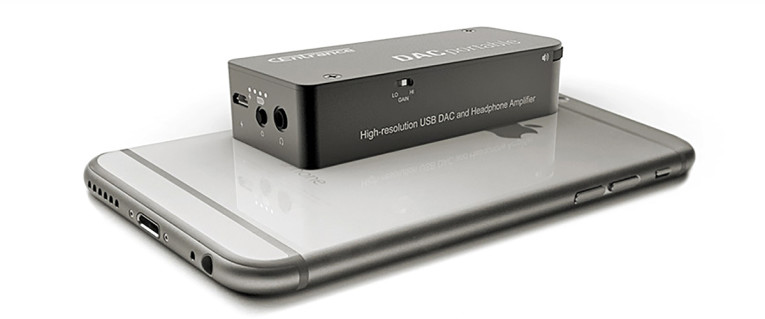
What about MQA?
Whenever the topic of DACs comes up these day, it seems a certain topic will soon follow and that’s Master Quality Authenticated (MQA). To be precise, does/will this or that DAC support MQA decoding? Prompted by TIDAL’s recent announcement that MQA streaming support is now active and curious about DACportable’s future upgradability, I posed that question to CEntrance Managing Director Michael Goodman, who said “We believe that MQA is an exciting new development in the audio industry and are watching market adoption. As an engineering firm, we don’t see hurdles to the technical implementation. As soon as the market momentum is there, we will be able to support it.”
Read the complete test bench report by Stuart Yaniger on the CEntrance DACportable, on the next page.



